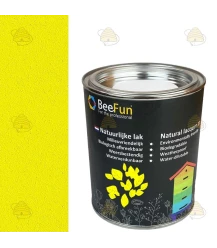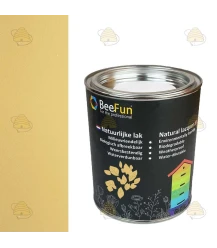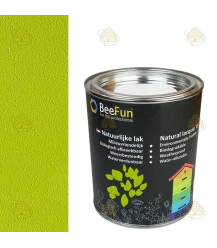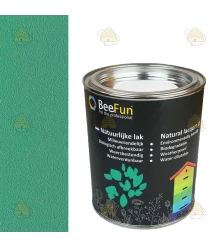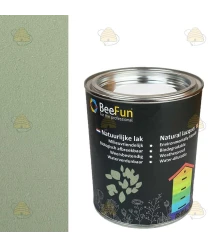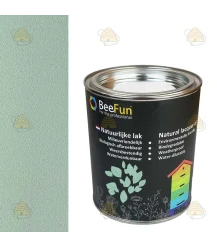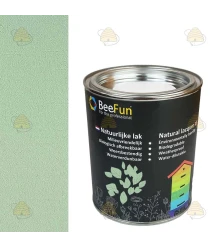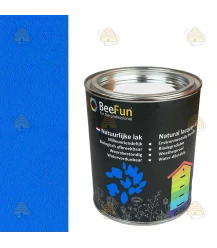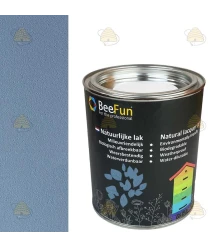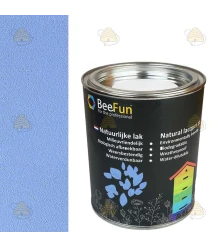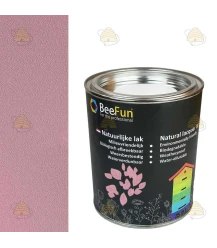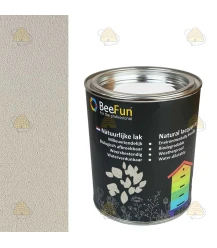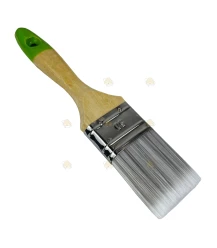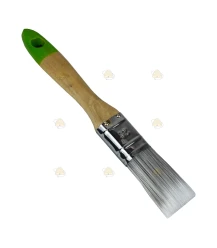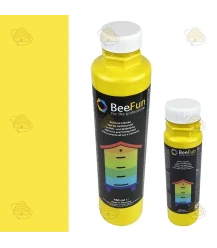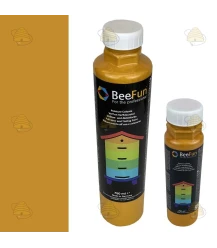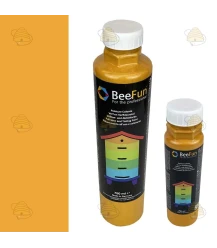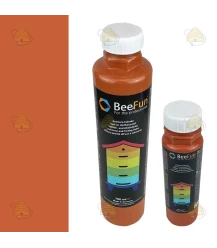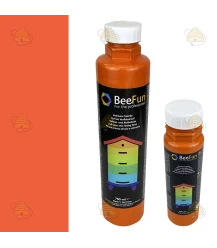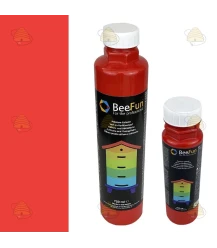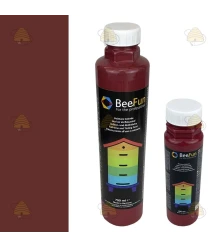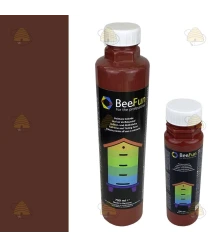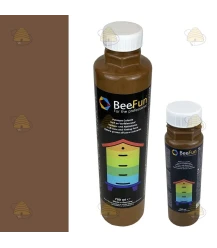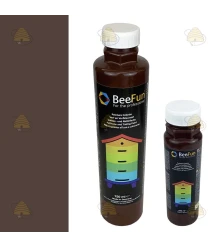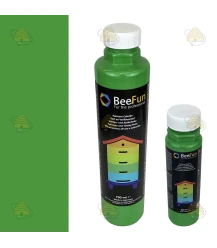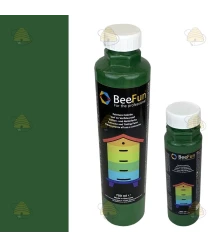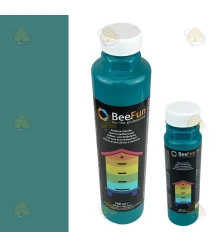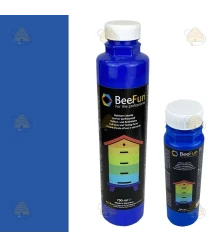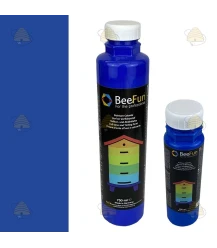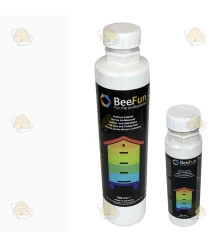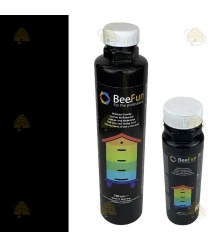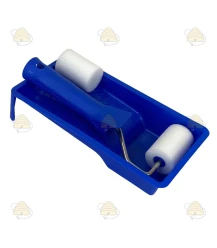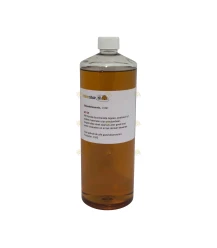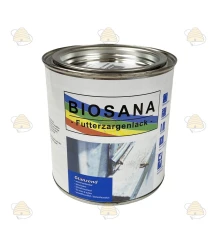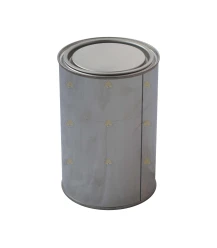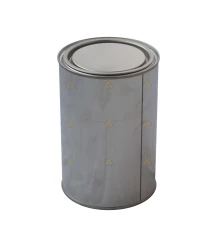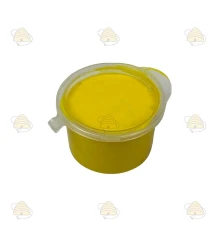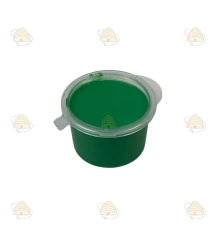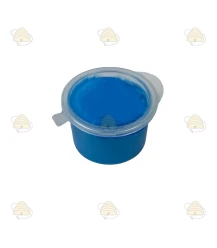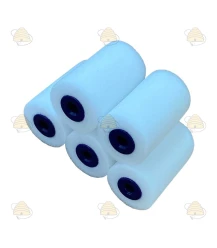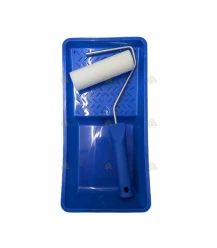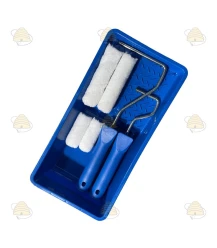Beehive paint
Painting your beehive is important for the longevity of the hive housing your colony. The paint layer provides protection for both wooden and plastic beehives. We can divide the surfaces of the beehive into different parts, namely: the outside of a wooden beehive, the outside of a plastic beehive, and the inside of both a wooden and a plastic beehive. In practice, the inside of a plastic beehive is never painted. On plastic beehives only the exterior surfaces are painted. For painting the inside of the plastic feeder, a special feeder varnish (Biosana varnish) can be used. When painting wooden beehives it is very important to cover the end grain thoroughly to prevent water ingress in rain. The inside of a wooden beehive is also not treated with paint, but you can treat it with, for example, Propoleum. You paint a beehive to make it last longer and to protect it against the weather. An unpainted wooden hive will quickly deform or warp due to moisture, and a plastic hive will weather over time under UV light.
-
BeeFun® Natural paint for wooden beehives yellow - 750 ml
€ 49,95 In stock and available for immediate delivery.Eco-friendly paint (lacquer), 750 ml, in yellow, for painting a wooden beehive. This paint is made from natural ingredients and is not harmful to the environment. In short, a new generation of paint for a modern, eco-friendly world. Beyond being eco-friendly, the paint is also high quality and extremely durable. Quick-drying (4 - 6 hours at room...View more -
BeeFun® Natural paint for wooden beehives honey color - 750 ml
€ 49,95 In stock and available for immediate delivery.Eco-friendly paint (varnish) per 750 ml in honey color, for painting a wooden beehive. This paint is made from natural ingredients and is therefore not harmful to the environment. In short, a new generation of paint for a modern, eco-friendly world. Besides being eco-friendly, the paint is also high quality and highly durable. The paint dries quickly (4 -...View more -
BeeFun® Natural paint for wooden beehives orange - 750 ml
€ 49,95 In stock and available for immediate delivery.Eco-friendly paint (enamel) in orange, 750 ml, for painting a wooden beehive. This paint is made from natural ingredients and is therefore not harmful to the environment. In short, a new generation of paint for a modern, eco-friendly world. Besides being eco-friendly, the paint is also high quality and extremely durable. The paint dries quickly (4 - 6...View more -
BeeFun® Natural paint for wooden beehives red - 750 ml
€ 49,95 In stock and available for immediate delivery.Eco-friendly paint (lacquer) 750 ml in red, for painting a wooden beehive. This paint is made from natural ingredients and is therefore not harmful to the environment. In short, a new generation of paint for the modern, eco-friendly world. Besides being eco-friendly, the paint is also high quality and extremely durable. The paint dries quickly (4 - 6...View more -
BeeFun® Natural paint for wooden beehives chocolate brown - 750 ml
€ 49,95 In stock and available for immediate delivery.Eco-friendly paint (varnish), 750 ml, in the colour chocolate brown, for painting a wooden beehive. This paint is made from natural ingredients and is therefore not harmful to the environment. In short, a new generation of paint for a modern, eco-friendly world. Besides being eco-friendly, the paint is also high quality and extremely durable. The paint...View more -
BeeFun® Natural paint for wooden beehives green - 750 ml
€ 49,95 In StockEco-friendly paint (varnish) per 750 ml in green/young houseplant green, for painting a wooden beehive. This paint is made from natural ingredients and is therefore not harmful to the environment. In short, a new generation of paint for a modern, eco-friendly world. Besides being eco-friendly, the paint is high quality and highly durable. The paint dries...View more -
BeeFun® Natural paint for wooden beehives apple green - 750 ml
€ 49,95 In stock and available for immediate delivery.Eco-friendly paint (enamel) per 750 ml in apple green, for painting a wooden beehive. This paint is made from natural ingredients and is therefore not harmful to the environment. In short, a new generation of paint for a modern, eco-friendly world. Besides being eco-friendly, the paint is also high quality and extremely durable. The paint dries quickly (4...View more -
BeeFun® Natural Paint for Wooden Beehives Turquoise - 750 ml
€ 49,95 This product is ordered, delivery time is approximately 7 days.Eco-friendly paint (varnish) in turquoise, 750 ml, for painting a wooden beehive. This paint is made from natural ingredients and is therefore not harmful to the environment. In short, a new generation of paint for a modern, eco-friendly world. Besides being eco-friendly, the paint is also high-quality and extremely durable. The paint dries quickly (4 - 6...View more -
BeeFun® Natural paint for wooden beehives khaki - 750 ml
€ 49,95 In stock and available for immediate delivery.Eco-friendly paint (varnish) in 750 ml, khaki color, for painting a wooden beehive. This paint is made from natural ingredients and is therefore not harmful to the environment. In short, a new-generation paint for the modern, eco-friendly world. Besides being eco-friendly, the paint is also high-quality and extremely durable. The paint dries quickly (4–6...View more -
BeeFun® Natural paint for wooden beehives green tea - 750 ml
€ 49,95 In stock and available for immediate delivery.Eco-friendly paint (lacquer) per 750 ml in Green Tea color, for painting a wooden beehive. This paint is made from natural ingredients and is therefore not harmful to the environment. In short, a new-generation paint for a modern, eco-friendly world. Besides being eco-friendly, the paint is high quality and extremely durable. The paint dries quickly (4 -...View more -
BeeFun® Natural paint for wooden beehives pistachio - 750 ml
€ 54,95 In stock and available for immediate delivery.Eco-friendly paint (lacquer) in 750 ml, in pistachio, for painting a wooden beehive. This paint is made from natural ingredients and is therefore not harmful to the environment. In short, a new generation of paint for the modern, eco-friendly world. Besides being eco-friendly, the paint is also high quality and extremely durable. The paint dries quickly...View more -
BeeFun® Natural paint for wooden beehives ocean blue - 750 ml
€ 49,95 In stock and available for immediate delivery.Eco-friendly paint (lacquer) in 750 ml in the color ocean blue, for painting a wooden beehive. This paint is made from natural ingredients and is therefore not harmful to the environment. In short, a new generation of paint for the modern, eco-friendly world. Besides being eco-friendly, the paint is also high quality and extremely durable. The paint dries...View more -
BeeFun® Natural paint for wooden beehives grey-blue - 750 ml
€ 49,95 In stock and available for immediate delivery.Eco-friendly paint (varnish) in grey-blue, 750 ml, for painting a wooden beehive. This paint is made from natural ingredients and is therefore not harmful to the environment. In short, a new-generation paint for the modern, eco-friendly world. Besides being eco-friendly, the paint is also high quality and extremely durable. The paint dries quickly (4 - 6...View more -
BeeFun® Natural paint for wooden beehives crocus blue - 750 ml
€ 49,95 In stock and available for immediate delivery.Eco-friendly paint (varnish), 750 ml, in crocus blue, for painting a wooden beehive. This paint is made from natural ingredients and is therefore not harmful to the environment. In short, a new generation of paint for a modern, eco-conscious world. Besides being eco-friendly, the paint is also high quality and exceptionally durable. The paint dries...View more -
BeeFun® Natural paint for wooden beehives lavender - 750 ml
€ 49,95 In stock and available for immediate delivery.Eco-friendly paint (lacquer) per 750 ml in lavender, for painting a wooden beehive. This paint is made from natural ingredients and is therefore not harmful to the environment. In short, a new generation of paint for the modern, eco-friendly world. Besides being eco-friendly, the paint is also high-quality and extremely durable. The paint dries quickly (4...View more -
BeeFun® Natural paint for wooden beehives cherry blossom pink - 750 ml
€ 49,95 In stock and available for immediate delivery.Eco-friendly paint (lacquer), 750 ml in cherry blossom pink, for painting a wooden beehive. This paint is made from natural ingredients and is therefore not harmful to the environment. In short, a new-generation paint for a modern, eco-friendly world. Besides being eco-friendly, the paint is also high quality and extremely durable. The paint dries quickly...View more -
BeeFun® Natural paint for wooden beehives ginger - 750 ml
€ 49,95 In stock and available for immediate delivery.Eco-friendly paint (lacquer), 750 ml, in ginger color, for painting a wooden beehive. This paint is made from natural ingredients and is therefore not harmful to the environment. In short, a new generation of paint for the modern, eco-friendly world. Besides being eco-friendly, the paint is also high-quality and extremely durable. The paint dries quickly...View more -
BeeFun® Natural Paint for Wooden Beehives White - 750 ml
€ 49,95 In stock and available for immediate delivery.Eco-friendly paint (lacquer) per 750 ml in white, for painting a wooden beehive. This paint is made from natural ingredients and is therefore not harmful to the environment. In short, a new generation of paint for a modern, eco-friendly world. Besides being eco-friendly, the paint is also high-quality and extremely durable. The paint dries quickly (4 - 6...View more -
BeeFun® Natural Primer for Wooden Beehives - 750 ml
€ 41,95 In stock and available for immediate delivery.Eco-friendly transparent primer (750 ml) for painting a wooden beehive. This paint is made from natural ingredients and is therefore not harmful to the environment. In short, a new generation of paint for a modern, eco-friendly world. Besides being eco-friendly, the paint is also high quality and highly durable. The paint dries quickly (4 - 6 hours at...View more -
Flat brush 50 mm
€ 5,45 In stock and available for immediate delivery.Flat paintbrush (50 mm wide) for painting the beehive or other paintable items. This brush has a wooden handle.View more -
Flat brush 25-30 mm
€ 4,35 In stock and available for immediate delivery.Flat brush (25 - 30 mm wide) for painting the beehive or other paintable items. This brush has a wooden handle. Handy brush for painting corners.View more -
BeeFun® Yellow Paint for Polystyrene Beehives
€ 6,95 In stock and available for immediate delivery.Yellow paint for painting a polystyrene/plastic beehive. Think of hives made of polystyrene, EPS, 'foam', etc. (This paint is not suitable for wooden beehives; choose our natural paint). This paint, specially for 'foam' beehives, has a nice, natural yellow color and for painting 1m² you need about 100 ml of paint (250ml = 2,5m² and 750 = 7,5m²). By...View more -
Paint for polystyrene beehives ochre BeeFun®
€ 6,95 In stock and available for immediate delivery.Ochre paint for painting a polystyrene/plastic beehive. This includes beehives made of polystyrene, EPS, styrofoam, etc. (This paint is not suitable for wooden beehives, choose our natural paint instead). This paint, specially designed for styrofoam beehives, has a beautiful, natural ochre color and for painting 1m² you need about 100 ml of paint (250ml =...View more -
Paint for polystyrene beehives apricot BeeFun®
€ 6,95 In stock and available for immediate delivery.Apricot paint for painting a polystyrene/plastic beehive. This includes beehives made of polystyrene, EPS, 'foam', etc. (This paint is not suitable for wooden beehives; choose our natural paint instead). This paint, specially for 'foam' beehives, has a nice, natural apricot color and to paint 1 m² you need about 100 ml of paint (250 ml = 2.5 m² and 750 =...View more -
Paint for polystyrene beehives terracotta BeeFun®
€ 6,95 In stock and available for immediate delivery.Terracotta paint for painting a polystyrene/plastic beehive. Suitable for beehives made of polystyrene, EPS, 'styrofoam' etc. (This paint is not suitable for wooden beehives, choose our natural paint instead). This paint, specially for 'styrofoam' beehives has a beautiful, natural terracotta color and for painting 1m² you need about 100 ml of paint (250ml...View more -
Paint for polystyrene beehives orange BeeFun®
€ 6,95 In stock and available for immediate delivery.Orange paint for painting a polystyrene/plastic beehive. This includes beehives made of polystyrene, EPS, 'styrofoam' etc. (This paint is not suitable for wooden beehives, choose our natural paint instead). This paint, specially for 'styrofoam' beehives has a beautiful, natural orange color and for painting 1m² you need about 100 ml of paint (250ml =...View more -
Paint for polystyrene beehives red BeeFun®
€ 6,95 In stock and available for immediate delivery.Red paint for painting a polystyrene/plastic beehive. Think of beehives made of polystyrene, EPS, 'Styrofoam', etc. (This paint is not suitable for wooden beehives; choose our natural paint instead). This paint, specially for 'Styrofoam' beehives, has a beautiful, natural red colour, and for painting 1 m² you need about 100 ml of paint (250 ml = 2.5 m²...View more -
Paint for polystyrene beehives wine red BeeFun®
€ 6,95 In stock and available for immediate delivery.Wine-red paint for coating a polystyrene/plastic beehive. Think of hives made of polystyrene, EPS, “Styrofoam”, etc. (This paint is not suitable for wooden beehives; choose our natural paint for those). This paint, specially for “Styrofoam” beehives, has a beautiful, natural wine-red color, and to paint 1 m² you need about 100 ml of paint (250 ml = 2.5 m²...View more -
Paint for polystyrene beehives brown-red BeeFun®
€ 6,95 In stock and available for immediate delivery.Brown-red paint for painting a polystyrene/plastic beehive. This is suitable for beehives made of polystyrene, EPS, 'styrofoam' etc. (This paint is not suitable for wooden beehives, choose our natural paint instead). This paint, specially for 'styrofoam' beehives has a beautiful, natural brown-red color and for painting 1m² you need about 100 ml of paint...View more -
Paint for polystyrene beehives brown topaz BeeFun®
€ 6,95 In stock and available for immediate delivery.Brown topaz paint for painting a polystyrene/plastic beehive. This is suitable for beehives made of polystyrene, EPS, 'styrofoam' etc. (This paint is not suitable for wooden beehives, choose our natural paint instead). This paint, specially for 'styrofoam' beehives has a beautiful, natural brown color and for painting 1m² you need about 100 ml of paint...View more -
Paint for polystyrene beehives brown BeeFun®
€ 6,95 In stock and available for immediate delivery.Brown paint for painting a polystyrene/plastic beehive. This is suitable for beehives made of polystyrene, EPS, 'styrofoam' etc. (This paint is not suitable for wooden beehives, choose our natural paint instead). This paint, specially designed for 'styrofoam' beehives, has a beautiful, natural brown color and you need about 100 ml of paint to cover 1m²...View more -
Paint for polystyrene beehives chocolate brown BeeFun®
€ 6,95 In stock and available for immediate delivery.Dark brown paint for painting a polystyrene/plastic beehive. This includes beehives made of polystyrene, EPS, 'styrofoam' etc. (This paint is not suitable for wooden beehives, choose our natural paint instead). This paint, specially formulated for 'styrofoam' beehives, has a beautiful, natural dark brown color and you need about 100 ml of paint to cover...View more -
BeeFun® Light Green Paint for Polystyrene Beehives
€ 6,95 In stock and available for immediate delivery.Light green paint for painting a polystyrene/plastic beehive. This includes beehives made of polystyrene, EPS, 'foam', etc. (This paint is not suitable for wooden beehives; choose our natural paint for that). This paint, specially for 'foam' beehives, has a beautiful, natural light green color, and for painting 1 m² you need about 100 ml of paint (250 ml...View more -
Paint for polystyrene beehives dark green BeeFun®
€ 6,95 In stock and available for immediate delivery.Dark green paint for painting a polystyrene/plastic beehive. This includes beehives made of polystyrene, EPS, 'styrofoam' etc. (This paint is not suitable for wooden beehives, choose our natural paint instead). This paint, specially for 'styrofoam' beehives has a beautiful, natural dark green color and for painting 1m² you need about 100 ml of paint...View more -
Paint for polystyrene beehives olive green BeeFun®
€ 6,95 In stock and available for immediate delivery.Olive green paint for painting a polystyrene/plastic beehive. Suitable for beehives made of polystyrene, EPS, foam etc. (This paint is not suitable for wooden beehives, choose our natural paint instead). This paint, specially designed for foam beehives, has a beautiful, natural olive green color and you need about 100 ml of paint to cover 1m² (250ml =...View more -
Paint for polystyrene beehives sea green BeeFun®
€ 6,95 In stock and available for immediate delivery.Sea green paint for painting a polystyrene/plastic beehive. This includes beehives made of polystyrene, EPS, 'styrofoam' etc. (This paint is not suitable for wooden beehives, choose our natural paint instead). This paint, specially for 'styrofoam' beehives has a beautiful, natural sea green color and for painting 1m² you need about 100 ml of paint (250ml...View more -
BeeFun® Mint Green Paint for Polystyrene Beehives
€ 6,95 In stock and available for immediate delivery.Mint green paint for painting a polystyrene/plastic beehive. Think of beehives made of polystyrene, EPS, ‘Styrofoam’, etc. (This paint is not suitable for wooden beehives; choose our natural paint instead). This paint, specially for ‘Styrofoam’ beehives, has a beautiful, natural mint green color, and to paint 1 m² you need about 100 ml of paint (250 ml =...View more -
Paint for polystyrene beehives lilac blue BeeFun®
€ 6,95 In stock and available for immediate delivery.Lilac blue paint for painting a polystyrene/plastic beehive. Think of beehives made of polystyrene, EPS, 'foam', etc. (This paint is not suitable for wooden beehives; choose our natural paint instead). This paint, specially for 'foam' beehives, has a beautiful, natural lilac blue color and for painting 1 m² you need about 100 ml of paint (250 ml = 2.5 m²...View more -
Paint for polystyrene beehives gentian blue BeeFun®
€ 6,95 In stock and available for immediate delivery.Gentian blue paint for painting a polystyrene/plastic beehive. Suitable for beehives made of polystyrene, EPS, 'styrofoam' etc. (This paint is not suitable for wooden beehives, choose our natural paint instead). This paint, specially designed for 'styrofoam' beehives, has a beautiful, natural gentian blue color and for painting 1m² you need about 100 ml...View more -
Paint for polystyrene beehives navy blue BeeFun®
€ 6,95 In stock and available for immediate delivery.Navy blue paint for painting a polystyrene/plastic beehive. Think of beehives made of polystyrene, EPS, 'foam', etc. (This paint is not suitable for wooden beehives; choose our natural paint instead). This paint, specially for 'foam' beehives, has a beautiful, natural navy blue colour and for painting 1m² you need about 100 ml of paint (250ml = 2.5m² and...View more -
Paint for polystyrene beehives white BeeFun®
€ 6,95 In stock and available for immediate delivery.White paint for painting a polystyrene/plastic beehive. Suitable for beehives made of polystyrene, EPS, 'styrofoam' etc. (This paint is not suitable for wooden beehives, choose our natural paint instead). This paint, specially for 'styrofoam' beehives has a beautiful white color and for painting 1m² you need about 100 ml of paint (250ml = 2.5m² and 750ml...View more -
Paint for polystyrene beehives black BeeFun®
€ 6,95 In stock and available for immediate delivery.Black paint for painting a polystyrene/plastic beehive. Suitable for beehives made of polystyrene, EPS, styrofoam, etc. (This paint is not suitable for wooden beehives; choose our natural paint instead). This paint, specially formulated for styrofoam beehives, has a beautiful black color and you need about 100 ml of paint to cover 1m² (250ml = 2.5m² and...View more -
Varnish set small foam roller
€ 5,45 Out of stockOut of stockPaint kit for painting both wooden and plastic beehives. This set includes a paint tray, a paint roller frame, and two foam rollers. Find all paint and painting supplies [category id=134]here[/category].View more -
Linseed oil varnish, 1 litre
€ 10,95 In stock and available for immediate delivery.Linseed oil varnish for treating beehives, contents 1 liter. It is a processed (boiled) linseed oil, specially formulated for treating the exterior of the beehive. This is a better choice than raw linseed oil. Raw linseed oil provides less protection. With 1 liter of linseed oil varnish you can treat about 15-20 m2. WARNING when using linseed oil...View more -
Biosana varnish for Segeberger feeders 375 ml
€ 12,95 In stock and available for immediate delivery.Biosana paint is designed for painting the inside of polystyrene (Segeberger) and/or a wooden feeder. The paint provides an extra protective layer in the feeder and helps prevent mold. The package contains 375 ml. Biosana is bee-friendly, solvent-free, and adheres well to wood and polystyrene. Biosana is manufactured in Germany.View more -
Propoleum, 1 liter
€ 18,45 In stock and available for immediate delivery.Propoleum is the treatment for protecting the interior of the beehive. It is a stain based on propolis (30%), alcohol (70%) and natural ingredients. Besides the interior, you can also use propoleum to protect the outside of the beehive. One bottle is enough for about two beehives. Both the outside and the inside should ideally be painted at least 2 times....View more -
Linseed oil varnish, 5 liters
€ 36,95 This product is ordered, delivery time is approximately 14 days.Linseed oil varnish for impregnating beehives. It is a processed (boiled) linseed oil, specially formulated for treating the exterior of the beehive. This is a better choice than raw linseed oil. Raw linseed oil offers less protection. WARNING when using linseed oil varnish. Rags, polishing wool, or other materials soaked with linseed oil are flammable....View more -
Yellow paint for polystyrene beehive 1 liter
€ 21,95 In stock and available for immediate delivery.Do you want to paint your beehive yourself? We offer yellow paint for touch-ups or painting polystyrene beehives in 1-liter cans. The paint has a deep, rich yellow color; this color is the same as the color of Imkershop’s polystyrene spaarkast hives. Note: Color may vary slightly between batches. Please note: this paint is not suitable for wooden beehives.View more -
Fresh green paint for polystyrene beehive 1 litre
€ 21,95 Out of stockOut of stockPaint for touching up or painting polystyrene beehives. Can contents: 1 liter. This is the same color as the green-painted [product id=1582]MiniPlus nuc boxes[/product] and [category id=187]BeeFun polystyrene[/category] beehives. Note: this paint is not suitable for wooden beehives.View more -
Blue paint for polystyrene beehive 1 litre
€ 19,95 Out of stockOut of stockPainting your beehive yourself? We have blue paint for touching up or painting polystyrene beehives, in 1-litre tins. The paint has a nice blue colour; this is the same shade as the polystyrene spaarkast hives from Imkershop. NB: Colour may vary slightly per batch. Please note: this paint is not suitable for wooden beehives.View more -
Paint pot for BeeFun® polystyrene hive yellow
€ 2,55 In stock and available for immediate delivery.Mini pot of yellow paint to touch up any damage to the paint finish of your BeeFun beehive. Note: this paint is not suitable for wooden beehives.View more -
Paint pot for BeeFun® polystyrene hive green
€ 2,40 In stock and available for immediate delivery.Mini pot with green paint for touching up any damage to the paint finish on your BeeFun beehive. Note: this paint is not suitable for wooden beehives.View more -
Paint pot for BeeFun® polystyrene hive - blue
€ 2,40 In stock and available for immediate delivery.Mini touch-up pot with blue paint for touching up any damage to the paint finish on your BeeFun beehive. Please note: this paint is not suitable for wooden beehives.View more -
Foam paint rollers set of 5 small
€ 3,25 Out of stockOut of stockSet of 5 paint rollers. These paint rollers work in combination with the handle from the [product id=4329]small paint set (#6922).[/product]View more -
Varnish set large foam roller
€ 7,95 In StockVarnish set with a large foam paint roller for painting, among other things, the beehive. This set includes a paint tray, a roller handle, and a foam roller. Both the tray and the foam roller itself are considerably larger than the small version. The foam roller is about 10.5 cm wide. You can find all paint and painting supplies [category...View more -
Varnish set large fleece roller
€ 7,95 In StockThis paint set is perfect for painting plastic or wooden beehives. The set includes 2 small (5 cm) and 2 large (10 cm) paint rollers and 2 roller handles. The tray consists of 3 inner trays and an outer tray. Choose convenience and a professional finish with this beehive paint set! Find all paint and painting supplies [category id=134]here[/category].View more
Which paint is best for painting a wooden beehive?
For wooden beehives we recommend BeeFun® wooden beehive paint. This is a natural paint with no chemical additives, ideal for animal housing such as the beehive. When you treat a beehive with this paint, it can go straight onto the compost heap at the end of its service life. This paint offers solid protection against the weather in the Netherlands and is made in Germany. If you still want to use a chemical paint that applies a kind of plastic film to the hive, we recommend a water-based paint such as acrylic paint. This is, of course, less eco-friendly.
A newer practice is to also treat the inside of the wooden beehive. This is painted with Propoleum. This extends the hive’s service life because moisture penetrates less. Propoleum can also be used very well on the outside of the beehive, preserving the beautiful natural color of the wood. If you use Propoleum on the outside too, you should touch up the hive regularly.
Which paint is best for plastic beehives?
For plastic beehives we recommend BeeFun® paint for plastic beehives. This paint contains a pigment that specifically forms a dense layer on the hive’s plastic material (such as foam, EPS, polystyrene) to block UV radiation. As a result, the material hardly/does not degrade under sunlight. This paint is available in small 250 ml bottles and larger 750 ml bottles. If you also want to paint the inside of your plastic beehive, you could use the Biosana feeder tray varnish. This helps seal the seams in the plastic, making it less susceptible to mold. In principle this varnish is mainly intended to make the feeder easier to clean after use, because it seals the micro-pores in the plastic.
Beehive maintenance
Of course you also need to maintain your beehive. This means repainting the beehive from time to time. A beehive in a bee house will need far less maintenance than a beehive standing outdoors. Plastic hives hardly need repainting, but small dents and damage that occur during use can be touched up with polystyrene repair paste. How often you need to paint wooden beehives depends on the weather exposure the hive faces. In a bee house, perhaps once every 10 years. Outdoors, without shelter, perhaps every two or three years. A beehive treated with Propoleum should receive a new protective coat every year. During the summer season you can swap parts so you have time to touch up components from previous years in the fall.
Brushes and rollers for painting
To make it even easier, we also sell the tools to paint your beehive, such as brushes and paint rollers. That way you can get started right away when you order your hive and paint together. A roller is convenient for larger surfaces of the beehive and gives a smooth, even finish. A brush is useful for joints and edges.

